Abriu no dia 25 de Junho de 2011 o novo Museu do Oceano e do Surf da autoria do arquitecto americano Steven Holl em colaboração com a arquitecta e artista brasileira Solange Fabião. Fernando Guerra fotografou durante três dias a vida no novo museu. Quem o inaugurou ou simplesmente por ali passou apressadamente num regresso da praia observou um encontro entre a cerimónia de inauguração trajada a rigor e a prancha de surf debaixo do braço. Figuras apanhadas numa estrutura que se estende perpendicularmente ao oceano em forma de onda côncava que alberga os edifícios translúcidos. Uma onda que é um palco privilegiado entre o céu e o oceano, como ilustrado nos desenhos conceptuais de Steven Holl que estão na raiz do projecto. Aqui nasceu um museu que alia a investigação científica do oceano ao aspecto lúdico de viver e partilhar experiências através de um desporto do qual, curiosamente, o próprio Steven foi praticante o que lhe confere um entendimento extra do espírito e da relação com o oceano.
Neste dossier especial feito em colaboração com o atelier de NY apresentamos essas imagens inéditas, bem como aguarelas do processo criativo, desenhos finais e textos sobre a obra escritos por quem a vê hoje concluída, nos quais se inclui o de um colaborador de longa data do atelier. Elementos que permitem a todos os que não podem passar por Biarritz, conhecer o projecto com alguma profundidade.
O site ultimasreportagens.com continua assim o seu trabalho não apenas de difusão da obra de um fotógrafo e da arquitectura nacional como também de edifícios de referência internacional. Depois de uma série de projectos na América Latina da autoria de Isay Weinfeld chega a vez desta obra de Steven Holl na Europa. Todos estes projectos constituem uma vasta base de dados e um acervo de recursos de consulta e referência que permanecerá disponível online. Eis o nosso objectivo diário.
Motivados pela singularidade deste projecto e pela reportagem que dele nasceu decidimos disponibilizar uma publicação impressa que documenta todo o processo. Um livro que pode ser facilmente encomendado on-line.
374 Fotografias | 1 Museu | 3 Dias em Biarritz
Textos de Yehuda Emmanuel Safran e Rodolfo Reis Dias
Aguarelas e desenhos de Steven Holl & Solange Fabião
Entrevistas de Carla Leitão a Steven Holl, Solange Fabião e Rodolfo Reis Dias
Desenhos técnicos
Créditos
Biografia de Steven Holl

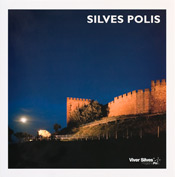
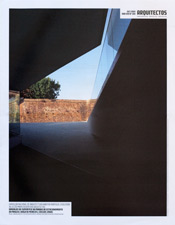
Perched on a hill high above the sea, walking distance from the shore of the bay of Biscay, la Cité de l’Ocean et du Surf in Biarritz was inaugurated on the 25 June 2011. The colors of the sea, the infinite marine horizon and the relatively unknown depth of the ocean, not to mention his own experience as a young surfer on the East coast of the Pacific Ocean, inspired Steven Holl to respond with a wave-like platform, perpendicular to the coastline, a platform from which three glass pavilions emerge like three great rocks in the sea. Below this gently curved platform with a nearly folded edge, the crown of the wave, is a vast curved ceiling, which provides the deep cavern, with reflected day light penetrating from three sides above and mirrored in the ceiling. Below this ceiling the permanent exhibition is installed. The first of the glass pavilions provides, like a reflected lens, most of the daylight below and the reception place above. The other glass pavilions contain a restaurant, bar and offer panoramic views of the bay with the zigzag profile of the mountains of the Basque country in the far distance. As the sun is about to sink beyond the horizon into the sea, people gather on the terrace with evident pleasure on their faces. On their left is the curved plane with an empty cavity, like a large empty eye gazing into to sky above, interrogating what can not be fathomed. In front of them there is a paved undulating paved surface that leads down to the sea far below. Inside-out, between sky and the earth the building is set below, on and above the earth. This feature provides an exhibition area to celebrate the surfer’s paradise of waves for which Biarritz is renowned, but also creates a crystal ball-like configuration with suspended bridge and stair cases inside. This architecturall invention will encourage the mind of generations to come, to reflect on the measured and known dimensions as much as on the immeasurable, unknown organic and inorganic depth of the ocean. Of course the city and its Mayor, Didier Borotra (Senateur-Maire), are proud of their achievement, with the help of the region and the council of Europe they add an important land mark to their landscape and their city, hopefully Biarritz which is a city of great natural beauty will benefit on this occasion architecturally as well.
This town deserves much better interventions than the speculative hotels which have flourished there since the aftermath of WW II. Urbanistically this project is on the edge of the city. Far away from La Grande Plage and its Casino, it provides a light house on the south in symmetry with the traditional marine light house on the north. Above all, it recalls the experience of Saint-Exupery’s Petit Prince, The Little Prince drawing of the hat. We are still carrying with us the image of the snake that swallowed an elephant. As architecture obeys the law of all works of art which is the condition of being a miniature, here in Biarritz we are invited to contemplate the mystery of the ocean in an enigmatic miniature. It is this quality which gives this architecture its force and beauty. Glowing at night like fragments of fire at sea, reposing as a fragment sea weed on the air, swept by the wind, one cannot remain indifferent. One might discern a Arte Povera quality of colors and materials, never pronounced, to allow the reflections of the powerful landscape and seascape to remain dominant and to add to our contemplative mood. As in Mies’ architecture, refined details which never call attention to themselves are there to meet the searching eye with an apt response. It is a rare challenge to be asked to respond to such a vast enigma as the Ocean. By far the largest part of earth, well known but hardly known well. The task of evoking the pleasures of the surfer as well as the adventure of future oceanographers, explorers, discoverer, scientists and poets is not a negligible one. Yet it is the mark of a great work that it does not provide an answer but create a comparable enigma, an almost “oceanic feeling” as Romain Rolland once called this ongoing encounter with a power beyond description.
–
Paris
Feb 2011






Cité de l’Ocean et du Surf in Biarritz is a project with three conditions unique to any previous experience Steven Holl Architects has had. It is a collaboration with the artist Solange Fabiao, it is the office’s first project in France, and it is not an art museum.
The collaboration amplified the singular result, by questioning, again and again, that moment when an office relies on its resources and previous work. Instead, we reinvented every single event.
Building atypically in France proved to be an intense process, based on research, economy and most of all, dialogue at the same table. Research – because each innovation must still respect the standard. Economy – because there is no budget for safe margins and therefore the final result is a long process of purging that which is not essential. Dialogue at the same table – because a deal is only closed when you shake hands. And in France, it has to be in French – it’s just a matter of culture.
Not being an art museum pumped the process full of uncertainty. What will happen inside this building? The lack of an answer during the entire process forced us to concentrate on architecture at its core: space, light and materials.
For whoever approaches the building from the sea, there is only landscape: a monolithic rock, made of white concrete and glass, a carved concave plaza that exposes a portuguese white stone, and grass texture. Two pure glass boulders resist erosion like uncovered diamonds.
Underneath this living geography, a single space solves the public program. It is unified by an immaculate, uninterrupted curved ceiling and a single light source with northern exposure. Long stairs and a bridge dive into the void and invite you to swim into a quiet volume, pierced unexpectedly by the gold sunset light that breaches a triangular window.
This building reflects the experience of being in the ocean, under the sky, under the sea.
–
Los Angeles
July 2011















Celebrating warm days (northern hemisphere…) can very well go hand-in-hand with welcoming the increasing presence of ocean or oceanic museums, and their inevitable site-specific qualities. This article looks at the Cité de l’Océan et du Surf building in Biarritz, France, which opened on June 25th and was designed by SHA (Steven Holl Architects) in collaboration with Solange Fabião. Also, this article includes exclusive interviews with the driving forces of the Architecture/Design Team (Steven Holl, Solange Fabião, Rodolfo Reis Dias), who, in turn, provide generous insight into the process, objectives and expectations of the design.
The Cité de l’Océan et du Surf in Biarritz, France, can be seen through the light of two to three increasingly interconnected architecture and urban design desires: buildings which become emblematic icons for the city where they are situated, buildings that aim to be parts of the city in and of themselves, and, lastly, interpretation centers – specifically Ocean Museums – interested in informative and educational endeavors and general environmental awareness-raising and their increasingly dominant strategy of interaction design around cultural practices to mobilize populations at large and their diverse cultural niches. The intersection of these traits is not uncommon and, instead, might evidence a convergence of topics around urbanity, public space, coastal areas and, of course, tourism and awareness-raising for problems facing the oceans.
The brief for the Cité at Biarritz was greatly interested in the tourism component of such a new building. The Cité would be providing one more dot on what can now be a more distinguished TGV-supported architecture pilgrimage that passes through Bilbao’s Guggenheim Museum (1997) – by Frank Gehry – and San Sebastian’s Kursaal Convention Center and Auditorium (1999) – by Rafael Moneo. Not unlike the older pilgrimage route that crossed several European cities – Way of St. James – which culminated in Santiago de Compostela’s cathedral, cultural and business tourism has proven to be a rather (economically) successful intersection to support the revitalization of some urban or historical areas.
On the one hand, common sense says that bodies of water are naturally appealing and sought out, and therefore tend to increase the value of surrounding areas, which is a justification for the (easy) success of these particular buildings to constitute public space – all populations are attracted to them. On the other hand, around major coastal cities, architectural additions near bodies of water – rivers or oceans that mark them – are often part of larger, phased reconfiguration plans that reconsider the ways in which the relationships between downtowns, ports and industrial areas can be transformed towards different economic and cultural objectives as roles of different infrastructural activities change, but also do socio-economic panoramas. This often includes remodeling obsolete structures for new uses, or adding new programs altogether. These water-adjacent areas are, therefore, often reclaimed land from industries, port areas or other private ownerships and become channels for the public to access the waterways and their history of alternating ownership.
The Cité (de l’Océan et du Surf) is already called only and justly that – Cité – in anticipation of its future role in becoming an identifiable piece or fragment which is more than a building that aims at continuing lines of public space, and, therefore, becomes a zone which can simultaneously reflect and engage Biarritz. At the heart of these transformations are changes in the relative functions and exchanges between programmatic and cultural characters and the realms of aesthetics that explore these new activities and eminently public connections. The architecture team was particularly interested in having an extended landscape design surrounding the building, which could extend and provide more potential for these linkages to evolve. These new relationships emerge as a reformation of that larger character that we know as the city – the reflection on its future role as an exchange center, and the ways in which there might be particular topologies that redefine the connections between the larger environment, institutions and citizens. It is for this reason that, at the Cité, the embracing wave design–which analogically suggests the continuation of folding topologies of the ocean further away–embodies important beginning movements not for its independent figuration, but for its attempt to exercise that continuity as a matter of fact.
We can find in some of the material choices the search for this particular monolithic quality which is nevertheless supple and flexible, such as the use of “calçada” – portuguese cobblestones – as the main plaza/exterior ground pavement; the particular tectonic feeling afforded by this material creates a more elastic layout where the connected levels and pathways are easily interchangeable.
Another strategy that speaks to this interest is the choice to create a seemingly underground building that reduces volume, thus allowing for a better contextualization with the surroundings as an open space, a negative plaza. This way, the plaza is at a better height difference from the main street level. This plaza level is activated by 2 volumes: the restaurant and surfer kiosk. The layout also provides different levels of independent entrance – literally different entry points – and use for different program spaces, i.e., the auditorium.
There is an increasing need to rethink the way in which buildings are the formalization of institutional spaces and can act as scaffolds or infrastructures for the societal transformations they are aiming at.
On the one hand, the increasing presence of virtual media in the programmatic body of the city implies that formalization might not reside or gain efficiency from the proper (physical) space of buildings – just as much as the old battle between program-function-form. On the other hand, media evolution and remote connectivity has created sharper and deeper comprehensions of what a locale is – including a deeper, layered understanding of how a location is formed by other places’ processes but also how it is relevant in processes happening elsewhere. In the case of the Cité, one can foresee a strengthening of the community’s bonds – including the sport of surf – as well the understanding of how distant places are influenced by each other, which includes the way in which the oceans are shared and affected by all. The hybrid typologies that include research centers and interpretation centers are nowadays extremely important for their dedication to diverse cultures of education and action promotion. The surf sport culture has a wide breadth of practices which appeal to the ocean education endeavor such as the captivation of younger demographics, the sport’s drive to foster understanding of geological and environmental circumstances and processes, and the pilgrimage/seasonal factor – many surf practitioners will travel to different surf spots – which lends itself to the creation of events and the promotion of a larger connectivity between different areas of the world through the understanding of their common process and/or linkages.
Much can be written about typologies that almost become stronger urban spaces than the cities they originated in: mall typologies are the usual reference for this. However, discussions around mall spaces are perhaps still bound to a way of understanding urbanity as density and the limit that contains/forms them – a modality that looks at cities in a rather conventional way and repeats stereotypes in attempts to recreate that density. A different modality – conventional in its own right – might look at the reshaping of infrastructural exchanges, through the creation of newly possible centralities.
Maybe Cité has initiated a set of bodies passing through itself which ultimately cross Biarritz, the region and elsewhere in such new way.
In the office website, the project is within the category Master Plans&Landscapes. Could you provide some comments regarding the context of the project and ambition provided by the brief?
As well, could you provide some insights regarding your particular conceptual response to this project and your ambitions for the overall project relationship with the surrounding landscape?
The ambition of the project working with the concept of “under the sky – under the sea” is to connect with the ocean horizon while fusing with the landscape. It is not so much a master plan – it is a museum space carved into the land and this unique ocean edge site.
We worked on the project over a period of six years, from the winning competition of July 2005 until the opening on June 25, 2011. During that time the exhibition content shifted from a focus on surfing culture to ocean science. The building’s relation to the site stabilized shifting changes of the interior program – a program that may change in the future.
The main concepts in the building – under the sky, under the sea – reflect the building’s two main spaces – exterior ‘plaza’ and interior main exhibit space. This apparently creates an exterior space that one could imagine as still museological (‘over the wave’). What do you find is this building’s attitude towards museums (the typology) and the making of public space? I am reminded of the way in which you worked museum space, landscape and public space in the Nelson-Atkins Museum of Art in Kansas City, Missouri.
The concave/convex interplay of space following the idea “under the sky – under the sea” begins with the asymmetrical position of the entry on the north with stepped ramp access to the main plaza. As one gradually rises into the space, it turns the body, cupping a large warp of space towards the ocean horizon.
Walking into it at midpoint, its tilt up in the eastern direction focuses you on the sky – so the dialogue of sea and sky is established early in the experience of the place. The south and north edges curve up in portuguese stones, the east tilts up toward the sky, and the west focuses on the ocean horizon.
The main exhibition space below is shaped by the giant curve with a pressure pushing down, which is lifted up by the light rolling in from the main entrance.
Instead of a museum typology of galleries and rooms, this space allows for flexibility of changing exhibits over time. A continuous wood floor over an air plenum keeps all air and services off the unbroken sweep of the curved ceiling.
This juxtaposition of public landscape space directly above exhibition space is different from the Nelson-Atkins Museum in its focus on the sea horizon with the warp of the open stone curve. Here the space is dedicated to the ocean and its mysteries.
The building seems to be very clearly drawing formal relationships with the boulders at sea. It almost feels like there is an inversion of a common approach to buildings near water bodies: rather than extending the museum out, your project seems to build a landscape by bringing the ocean in. Could you provide some comments on this strategy and your interest in these landscape features?
Embedded in the main warped surfaces are two “glass rocks,” which are analogous to the two giant stones on the beach in the distance. These elements – a restaurant and a surfer’s kiosk – are sheathed in special “Okalux” glass, cutting sunlight transmissions while appearing close-up like the foam of the sea – “l’écume de la mer.” Aspects of the ocean are drawn into this composition in an aim to “build the site.” An “empty pool” for skateboarders is cut into a surface cut to form an ocean porch. The warp of the surfaces establishes special experiences of the body moving in space. This especially comes alive with people in the plaza. From one perspective you can see only heads and shoulders, and shadows on the sandblasted glass. From another perspective you can see a grouping of figures from the waist down.
The up and down cutting east and west is a spatial dynamic always balanced by the infinitely straight horizon. It is analogous to being on a rolling sea, when you dip down in a valley of water and are spatially enclosed… then the sea lifts you on top of a roll and you can see in every direction. When the sunlight catches the sandblasted glass guardrails curving up, they glow like a ridge of foam on a sea wave.
The materiality of this building is very important – as is the materiality of the sea. The main surface and structure is white concrete cast in a flaked board formwork; its texture is simultaneously hard and soft. The “glass rocks” are framed in special steel “T” sections that hold the white translucent glass. From the grass between portuguese stones, one steps up on wooden stairs and a wooden café platform with a panoramic sea view. Due to sinking the main body of the building in the earth, very little cooling or heating is required.
Museums are often defined by narratives their contents prescribe, and their apparently free, large and sometimes flexible spaces are very frequently prescriptive towards a particular exhibitive strategy. What were your interests and strategies regarding prescriptive and non-prescriptive space, regarding the content of the museum?
We were interested in an open and flexible exhibition space strategy which rides below a direct engagement with the sea horizon. The lower set of spaces can flow in and out, changing like currents, while the upper set of spaces fixes the body in a series of different relations of the sea and sky. Instead of a building type, it is a place of shifting perspectives; a phenomenal platform dedicated to a feeling of oceanic space and the immeasurable.Architect and Artist, Lead Architect, Co-Author
I would like to know more about the nature of your involvement in the project, and your specific take on the project brief and ambition?
My first collaboration with Steven where I participate as co-design took place in 1999 for the project Xky Xcraper, a high-rise in Voosari, Finland that received honorary mention from the Finnish Association of Architects. Since then we have collaborated in many projects. In 2005 he invited me to be the co-designer for the Cité de L’Océan et du Surf in Biarritz. At that time the office was very busy and the Cité was a too special of a project for its theme and situation, I accepted the invitation. Of course being born in Rio de Janeiro makes the Cité’s theme a given. Steven also had surfed on the West Coast and we thought this would be a great project to collaborate.
I like to compare architecture to film making, there are several functions in the execution of a building and so in a film. In a film there is the director, the scriptwriter, the producer and so on. In architecture among many functions there is the designer, the one that comes up with the essence of what the building will be, that comprises information to make the building work in all levels. My work as artist and architect is to bring original ideas in accordance with the understanding of the intention of the project, to make analysis of the situation towards a conceptual, a formal and functional result. This includes site analysis and urban planning, taking in consideration the environment and its ecological aspects as well as developing plan, elevations, circulation, areas, materiality and so on. For the Cité the conceptual/spatial idea came to me through a dream, the idea of an “encased wave”. Following this dream I developed a first 3D sketch that gave the main direction for the design, the great curve, the volume under and the plaza above, the two sides expressed by the concave and convex, the connection with the ocean, the diversity of the curvilinear with the introduction of the skate-pool were the starting point for the design and together with Steven we integrated the idea to the site, he introduced the “glass boulders” to the plaza connecting to the rocks at the beach in front and after the definition of our conceptual sketches I started to develop the plan to see how far the idea would really work further for the competition. I have been working solid in this project for the past 6 years. I am, see myself as an artist and architect but don’t see myself having my own architecture firm. As design architect I like to collaborate with firms that think my skills are useful, are enhancing.
In the context of your practice, are there particular points of connection between this project development and other aspects of your work as an artist?
It is part of my artistic philosophy to integrate diverse forms of expression. Already at the early stages of my career one sees this aim. I studied architecture, received my BFA as set designer, worked for television and theater and I am a painter since very early on. I find the development of perception in various creative fields as well as in experiencing various cultures enriching. This approach results in a certain kind of perception that is more permeable.
When I try to find a connection between my art and my architecture and here specifically with the Cité I find a search for the essential, the search for a core element as defining in the work. The great curve, its dynamics expresses the essence of the ocean and the surf. One can immediately perceive it when encountering the building. My work is diverse and complex but has a very precise message in each project, formally and conceptually. I have possibly by being as well an artist developed a certain freedom of expression, receiving the original idea for the Cité through a dream shows such freedom ñ from unconscious to consciousness.
In another hand my first conceptual art project the “Diagonal System” (1987-1993) which handles with the limits of space and movement, is also a search, for mediation between the bidimensional, representation and tridimensionality has been evident throughout my career and certainly defining in the creation of the geometry of the Cité. At the Cité though the limit, this intersection is the sea, its profundity when it touches the open sky.
You worked on this project from day 1 of the competition phase as the leading Project Architect. Regarding the development of the main concept – under the sky, under the sea – what were the main strategies you found key regarding circulation and the experience that engaged the theme of the museum, landscape and public space?
Steven Holl uses watercolors to develop his ideas for projects. We began the competition process this way. Steven and Solange produced a group of watercolors describing two schemes, and I responded with models integrating the building shape into the sloped site. Over a weekend at their house in Rhinebeck, S+S worked on a new group of watercolors, a development of the first, but now fused with the landscape. The watercolors settled on a single scheme and provided a very detailed architectural concept for the entire museum–plans of each floor, sections and perspectives.
In my opinion, the literal description of the visual idea is secondary to the models but serves to communicate the notion of a building divided in two parts: a concave public plaza that extends through the landscape all the way to the sea–under the sky–and underneath, a large gallery– under the sea.
All the public areas are along the Northern crest of the building: entrance, access to galleries, shop, cafeteria and restaurant with access to the sloped plaza, and at the highest point, like a prow, a terrace with views of the sea and mountains. These areas are completely free and open to the public.
The controlled areas are along the Southern crest: museum administration, storage, auditorium, technical areas, and an additional gallery.
Regarding this same concept – how were materials choices and intersections with regarding the same strategies?
The site is a harsh, salty environment, so materials were selected for durability: exposed concrete, limestone and glass. We wanted the building to be as light and monolithic as it could be. So we chose white concrete, both smooth and textured, portuguese white limestone cobblestones, and three types of low-iron glass. For the guardrails we used sandblasted glass, for the boulders, a mix of clear and Ocalux glass–an insulated product filled with white capillaries that filter light.
From the exterior, you experience the white concrete facades. From within the plaza, you see the limestone cut into square pavers. From the porch underneath the plaza, you see all the materials join together as a monolithic whole–the textured concrete walls, the smooth concrete belly of the skater’s pool, the cobblestone floor that leads the way to the sea.
Could you provide us some insights into issues regarding integration in the site, from a design but also from a construction and final ambition of the experience perspective?
The museum is 300m from the sea, which is the minimum distance from the coastline that French law allows. It is in a small scale residential community, so burying some of the building’s volume reduced the impact of its size. However, there is water underneath, and we had to be careful not to excavate too much, and maintain the site’s original topography. The levels inside were adjusted to this topography.
–
Carla Leitão is an architect, designer and writer currently living, working and teaching Architecture in New York. Practice and academic works interests in ubiquity and intersection of new media and architecture.
Courtesy Huffington Post




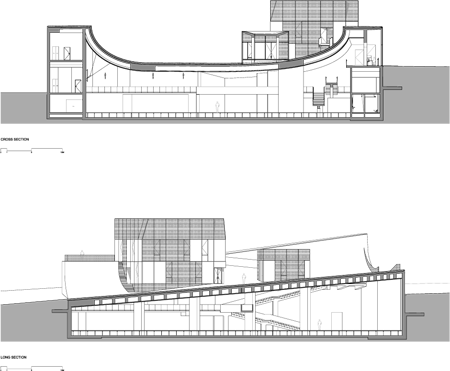
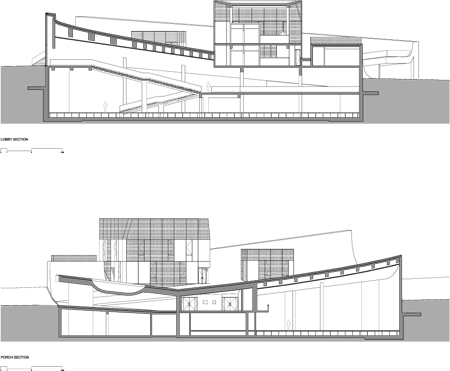
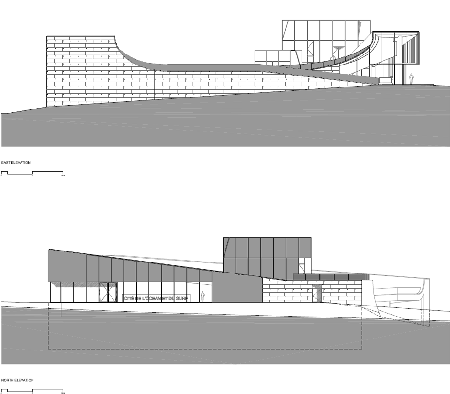
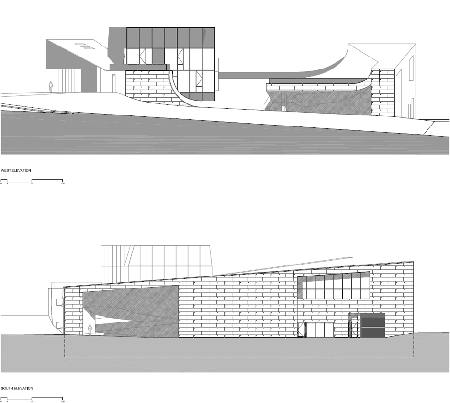
The Cité de l’Océan et du Surf Museum intends to raise awareness of oceanic issues and explore educational and scientific aspects of the surf and sea and their role upon our leisure, science, and ecology. The project, designed in collaboration with Solange Fabião, is comprised of a museum building, exhibition areas, and a plaza, within a larger master plan. The building form derives from the spatial concept “under the sky” / “under the sea”. A concave “under the sky” shape creates a central gathering plaza, open to sky and sea, with the horizon in the distance. The convex structural ceiling forms the “under the sea” exhibition spaces. This concept generates a unique profile and form for the building, and through its insertion and efficient site utilization, the project integrates seamlessly into the surrounding landscape.
Program:
Exhibition area, auditorium, restaurant, cafeteria and offices
Client:
City of Biarritz / Adim Sud Ouest
Size:
3800 sm
Credits:
Architect:
Steven Holl Architects
Design architect:
Solange Fabião
Steven Holl
Project architect:
Rodolfo Dias
Project advisor:
Chris McVoy
Assistant project architect:
Filipe Taboada
Project team:
Francesco Bartolozzi
Christopher Brokaw
Cosimo Caggiula
Florence Guiraud
Richard Liu
Johanna Muszbek
Ernest Ng
Alessandro Orsini
Nelson Wilmotte
Ebbie Wisecarver
Lan Wu
Christina Yessios
Rüssli Architekten
Justin Rüssli, Mimi Kueh, Stephan Bieri, Björn Zepnik (project team DD/CD)
Associate architects:
Agence d’Architecture X.Leibar JM Seigneurin
Structural consultant:
Betec & Vinci Construction Marseille
Acoustical consultant:
AVEL Acoustique
HVAC consultant:
Elithis
General contractor:
Faura Silva, GTM Sud-Ouest Batiment
Exhibition engineer:
CESMA
Exhibition contractor:
Geroari
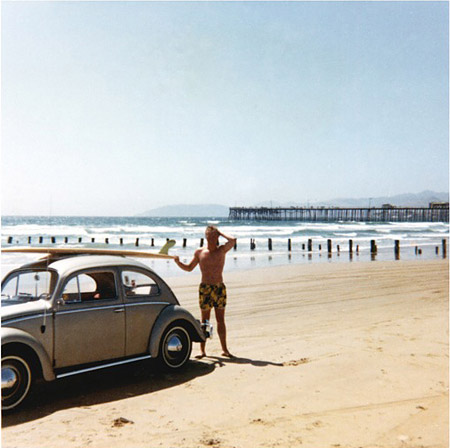
Steven Holl was born in 1947 in Bremerton, Washington. He graduated from the University of Washington and pursued architecture studies in Rome in 1970.
In 1976 he attended the Architectural Association in London and established Steven Holl Architects in New York City. Considered one of America’s most important architects, Steven Holl is recognized for his ability to blend space and light with great contextual sensitivity and to utilize the unique qualities of each project to create a concept-driven design. He specializes in seamlessly integrating new projects into contexts with particular cultural and historic importance.
Steven Holl has been recognized with architecture’s most prestigious awards and prizes. Most recently, Steven Holl received the first ever Arts Award of the BBVA Foundation Frontiers of Knowledge Awards. Steven Holl Architects’ Linked Hybrid received the AIA NY 2008 Sustainable Design Award. The Nelson-Atkins Museum in Kansas City received the AIA 2008 Honor Award. In 2007 the School of Art & Art History (University of Iowa, Iowa City) received the AIA 2007 Institute Honor Award and the AIA New York Chapter 2007 Merit Architecture Award. The Center Section at the Pratt Institute (Brooklyn, New York) and the New Residence at the Swiss Embassy both received the AIA New York Chapter 2007 Honor Architecture Award. In 2006 Steven Holl received honorary degrees from Seattle University and Moholy-Nagy University in Budapest. Earlier in 2006 he was awarded the AIA New York Architecture Merit Design Award for the Planar House, the 2006 AIA New York Architecture Project Citation Award for Sail Hybrid, and the 2006 European Hotel Design Award for Loisium. Among the other recent awards are the 2005 New York Chapter American Institute of Architects Honor Award for the Whitney Water Purification Facility and Park. In 2003 he was named Honorary Fellow of the Royal Institute of British Architects (RIBA). In 2002 the Cooper Hewitt National Design Museum, part of the Smithsonian Institute, awarded him their prestigious National Design Award in Architecture. In 2001 France bestowed the Grande Médaille d’Or upon him, for Best Architect of the Academy of Architecture; and in the same year Time Magazine declared him “America’s Best Architect” for his ‘buildings that satisfy the spirit as well as the eye’.
Steven Holl is a tenured Professor at Columbia University’s Graduate School of Architecture and Planning. He has lectured and exhibited widely and has published numerous texts including Anchoring (1989), Parallax (2000), Idea and Phenomena (2002), and Luminosity/Porosity (2006). In early 2007 two new books were published; House: black swan theory (Princeton Architectural Press), and Architecture Spoken (Rizzoli).
Steven Holl is a member of the American National Council of Architectural Registration Boards (NCARB), the American Institute of Architects, the American Association of Museums, the Honorary Whitney Circle, the Whitney Museum of American Art; and the International Honorary Committee, Vilpuri Library, of the Alvar Aalto Foundation.
FG+SG Architectural Photography All Rights Reserved